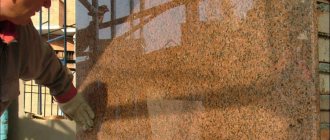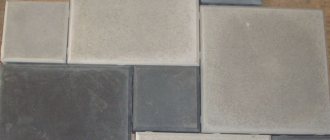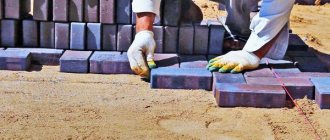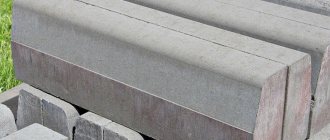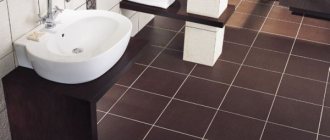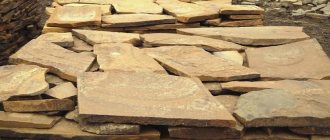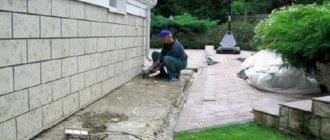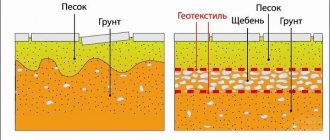When landscaping a suburban area, many people ask questions about the difference between paving stones and paving slabs. After all, using both methods you can implement an attractive landscape design in an original and stylish way. Neat paved garden paths are perfect for zoning any spaces of this format.
In fact, making a sidewalk yourself is not at all difficult. Many people simply fill it with sand, crushed stone or gravel and fill it with concrete. But not everyone is satisfied with the resulting properties and characteristics of this format of garden path due to low strength, insufficient durability and other significant aspects.
Many owners of modern plots do not distinguish the difference between paving stones and paving slabs, mistakenly perceiving them as the same material. This is due to a set of truly similar characteristics and features. But in reality everything is completely different.
There are differences in shape, dimensional lines, thickness, and mechanical properties. Therefore, these options are completely different materials, each of which is better suited to certain conditions and requirements.
Paving slabs
Let's try to figure out what the difference is between paving slabs and paving stones through a detailed comparison of the two options. First, let's look at the manufacturing process. Paving slabs can be made from concrete mortar of different colors. Concrete is poured by vibration casting or vibrocompression.
This method provides high strength characteristics by minimizing air voids. Thanks to this, high reliability, durability and wear resistance are achieved with respect to moisture, mechanical action, corrosion, ultraviolet radiation, and temperature changes.
Another significant aspect is stability and the ability to withstand significant loads.
The production of tiles here is much simpler when compared to paving slabs or paving stones. This has a direct impact on the final cost of the resulting products. In addition to all of the above, tiles offer a wider variety of colors, designs, patterns, styles, and shapes.
How to choose paving slabs?
If paving slabs are purchased to improve the local area, when choosing, you should pay attention to several factors:
- Cement-based material is checked by sound: a ringing sound indicates that everything is normal, and a dull sound indicates an excess of water.
- You need to be wary of saturated colors of the coating. A trusted manufacturer puts an expensive pigment into the mixture, while an unscrupulous one may use a cheap dye that washes out over time.
- The surface of the product must be free of bubbles, chips, cracks, and evenly colored.
Paving slab material
Depending on the material, the following types of paving slabs are distinguished:
- Concrete paving slabs
. Made from cement, crushed stone and water. The product allows moisture to pass through, so puddles will not remain on the surface. - Clinker paving slabs
. It is made from special clay, has a rough surface, and is very durable. - Plastic paving slabs
. It is 100% made of polymers - polyvinyl chloride or polypropylene. The material has a lattice structure and is suitable for arranging garden paths, zoning beds, and arranging areas around swimming pools. - Polymer sand paving slabs
are made from polymers (25%) and sand (75%) with the addition of dyes. It is durable, frost-resistant, lightweight and has excellent moisture resistance. Such tiles will pleasantly surprise you with a huge range of shades; you can use them to create masterpieces of landscape design. - Rubber paving slabs
. It is made from crumb rubber, colored filler and polyurethane binders. The material is soft, elastic, non-slip, and is often used for finishing sports and children's playgrounds. - Tactile paving slabs
. It has convex elements on the surface (cones, linear slits) so that a person with poor eyesight and with a stick can navigate where to go.
Paving slab sizes
The thickness of paving slabs is selected based on the conditions in which it will be used:
- The optimal tile for paths, paths, pedestrian areas is 30 mm thick.
- Universal tiles with a thickness of 50-60 mm have a wide range of uses. It can be used to lay out a yard, a driveway, or a park area.
- Tiles with a thickness of more than 70 mm are intended for areas with high loads.
The most popular paving slabs are:
- Square
– 300x300 mm, 350x350mm, 400x400mm. - Rectangular
– 200x100mm, 250x125mm.
Shapes of paving slabs
Several forms of tiles are in great demand:
- Clover
. The tile resembles a clover leaf, the coating is decorative. - Wave paving slabs
. The shape of the product follows the curve of the wave. The tile creates a beautiful pattern and is available in different colors. - Paving slabs brick
. It has a traditional shape with smooth edges, imitating brick. - Reel
_ The product is shaped like a spool on which threads are wound. - Diamond
_ From samples of several colors you can lay out stars, geometric shapes, 3D patterns on the surface. - Hexagon
. A mosaic pattern is beautifully laid out from such tiles.
Shape and size of paving slabs
In fact, paving slabs can be absolutely anything compared to paving stones. If some of the products are manufactured in a factory, others can be made independently or made individually to order.
In this regard, paving slabs can fit any size and be both large and very small. Moreover, the execution itself can take different forms.
View this post on Instagram
Posted by GranilitLugansk (@granilitlugansk) Sep 8, 2021 at 1:52 PDT
For example, coils, snakes, waves, antiques, bricks, diamonds, squares, trapezoids, mosaic formats, rings and much more. When laying, it is easiest to use the same color for uniform laying. To do this, it is recommended to purchase products from one batch to ensure uniformity in terms of color.
Read also: What types of brick-like clinker tiles are there for interior decoration?
The thickness of paving slabs can be as follows:
- Pedestrian corresponds to values up to 30 mm. It is used to create sidewalks, blind areas around a country house, paths in the garden, steps and areas located in close proximity to the porch, sometimes in gazebos.
- Universal can have dimensions up to 60 mm. It is well suited for the implementation of park areas, paths of various formats, and for the design of local areas.
- Monolithic must correspond to numbers up to 80 mm. It is used to organize driveways, as well as parking areas where there is increased load due to the presence of cars of different weights.
If we are talking about paving slabs for areas located in close proximity to a country house, then the thickness of the tiles is usually 30-60 mm. It guarantees decent quality of the coating and meets all the requirements for this type of product.
The shape of paving slabs, unlike paving stones, most often has the following design:
- square 30 by 30, 35 by 35, 40 by 40 and 50 by 50 cm.
- Rectangular 20 by 10 or 25 by 12.5 cm.
- The figured one can be made either in a standard solution or in an original form, so the most commonly used options here are as follows: 29.5 by 29.5, 20 by 16.8, 12 by 18 and 12 by 19 cm.
In addition, the difference between paving stones and paving slabs is that the latter has the following marking options:
- square (K);
- rectangular (R);
- hexagonal (W);
- curly (F);
- to make a border (D);
- road decoration (EDD).
You should also take into account in the name of any paving slab, in contrast to paving stones, such a moment as an indication of the type of concrete present in the composition. Accordingly, it starts with the smallest numbers, and the higher its value, the higher the strength of the final material.
Read also: Which adhesive for porcelain tiles is better?
What is the difference between paving slabs and paving stones?
Unlike tiles, paving stones are turned stone bars in the form of a cube or brick made of hard rocks - granite, basalt. Its paved surface is polished over the years, and the coating withstands the tests of hundreds of years. Typical examples of paving stones are ancient pavements or Red Square. This material stands out for its solemnity and timelessness.
Do not confuse paving stones and paving slabs; their differences are:
- The main difference is in thickness. For paving stones it is equal to its length and width.
- Due to their thickness, paving stones can withstand very heavy loads; the material is indispensable in crowded areas and on roads with heavy traffic.
- Paving slabs for paths are 5-6 times cheaper, because their production is less expensive.
- The service life of paving slabs is shorter than paving stones.
- Paving slabs are smoother and more comfortable for pedestrians.
- The tile attracts with its variety of installations. The material can also have a shaped shape. Spider web paving slabs stand out with their pattern right on the surface. While paving stones are produced mainly in the form of squares or rectangles.
More about the characteristics
Despite everything, not knowing the difference between paving stones and paving slabs, most people turn to the appearance of both options. And whatever one may say, the latter is distinguished by great variety, which can pleasantly surprise even a sophisticated user.
There is not only a lot of technology here, but also a lot of components that can actually be used in different proportions, which makes the final result original.
By type, paving slabs should be divided into:
- Vibrocast, which is made by vibration casting and has increased strength properties. At the same time, it can be designed in different shapes and sizes.
- Vibrocompressed is produced on the basis of sand and cement. In this case, a small amount of water is used. The entire resulting solution is carefully compacted using a press, due to which high strength is achieved. This option has a limited number of variations in shape.
- The polymer one is made on the basis of a waterproof material that has a set of holes for water outflow. More suitable for baths, swimming pools and other rooms with high humidity levels.
- Polymer-sand is made on the basis of polymers and sand. Meets easy installation properties and has good performance.
- Rubber is used less frequently, but is widely used in places where there are increased demands on the grip between shoes and the ground.
Based on all the previous factors, a list of advantages of paving slabs as opposed to paving stones should be highlighted:
- low cost;
- wide range of dimensional lines and shapes;
- many color solutions in terms of shades and scales;
- ease of installation, repair and dismantling;
- high strength and wear resistance to external factors, including exposure to moisture, fire, temperature changes;
- environmental safety for people and the environment.
How to make paving slabs?
To make paving slabs, you will need:
- cement;
- sand;
- granotsev;
- superplasticizer;
- dye (optional).
Do-it-yourself paving slabs - manufacturing process:
- Mix the solution - 10 kg of sand, 5 kg of cement, 30 g of plasticizer, a bucket of water. In addition to these components, you can add granotsev. Then the ratios in the solution are as follows - 2 parts of gravel, sand and cement per 30 g of plasticizer. The composition should be viscous.
- Pour the solution into molds.
- Forms with solution should be placed on a vibrating table for 2-3 minutes. To do this, it is appropriate to use even an old washing machine in spin mode. After vibration, air bubbles can be seen emerging from the surface of the solution.
- The tiles are laid out on a flat rack to dry.
- After two days it can be removed from the molds.
Forms for paving slabs
To make paving slabs with your own hands, you will need molds that can be used to create products of the same size. They are made from high quality plastic. The material can withstand a large number of production cycles, does not crack or lose shape. Templates are presented in a huge assortment - from ordinary bricks to clover, heather, scales, and bikinis. The surface of the material can be either smooth or with any pattern. Popular options include imitation of ancient paving stones, natural stones, and boulders.
Recommendations for selection
When such a difficult question sometimes arises as to choose paving stones or paving slabs, a number of certain criteria should be taken into account. Let's take a closer look at them.
To choose paving slabs, you need to focus on the following aspects:
- When choosing cement-based products, you need to follow a simple procedure: hit the products against each other and listen carefully. The sonority will indicate compliance with all the requirements for this technology. Deaf will reflect the situation with the presence of additional additives, which will be reflected in a decrease in service life.
- The color should spread evenly over the surface of the products, including breaks. That is, they should not correspond to excessive brightness. But if there is a need for bright and distinct colors, then it is better to use manufacturers that have already proven themselves on the market. It should be understood that dishonesty on the part of the creators leads to a negative effect in the form of washing out the color. This is typical in situations where the main shade is uneven.
- Yellow spots on the back side will reflect the presence of sand and clay, which also negatively affect a number of basic components.
- A mandatory requirement will be the absence of chips, cracks and bubbles.
Read also: How to choose porcelain tiles for the floor?
What is the difference between paving stones?
But don’t forget about the second option and consider it more carefully. Let us tell you the difference between paving stones and paving slabs. The products themselves have different sizes, and at the same time they are made of natural stone. It can be enlarged and wide or small and neat. The most common shapes are rectangle or square.
Natural stone for making paving stones undergoes careful processing. But based on its permanent properties, the final result has no less strength, wear resistance and durability compared to paving slabs.
Manufacturing is based on granite, marble, sandstone and several other solid types of stones. With the help of a special tool, paving stones are transformed from hard materials into more pliable variations, which are already useful in everyday use on modern suburban areas.
It should be remembered that roads laid out on the basis of paving stones many centuries ago have survived to this day. Therefore, here it wins in comparison with the first option.
The difference between paving slabs and paving stones lies in the increased weight of the latter. Can reach up to 100 kg per 1 square meter. By type it is divided into:
- sawn;
- chopped;
- split-sawn.
Similar articles:
Options for laying paving slabs
There are several options for laying paving slabs:
- brick;
- in a checkerboard pattern;
- herringbone;
- with imitation weaving;
- round;
- creating a chaotic pattern.
“Herringbone” is characterized by the diagonal direction of the lines. The checkerboard pattern consists of tiles of contrasting colors, laid out one after another. When creating a circular template, circles are drawn. When paving with paving slabs, materials of different colors are often combined. It can be used to lay out geometric shapes, stripes of the same or different widths, and spectacular patterns from products of different shades.
